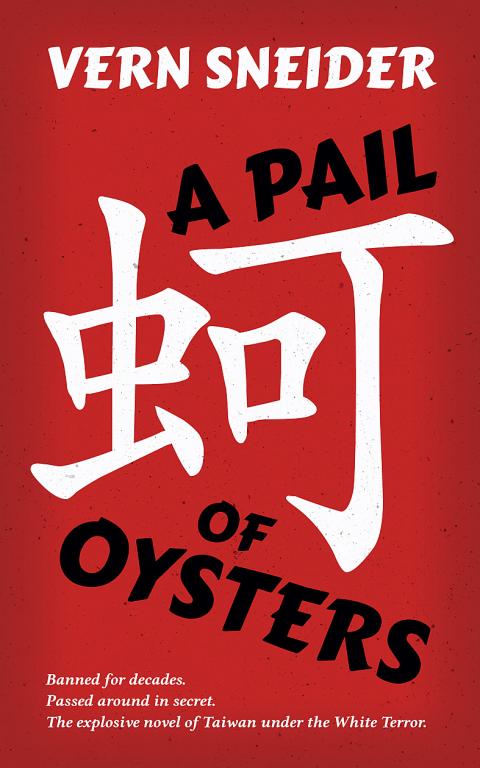Hot on the heels of the success of his debut novel, The Teahouse of the August Moon, American author Vern Sneider spent the summer of 1952 in Taiwan researching his next book.
Ushered in by the 228 Incident of 1947, the White Terror era was at its most brutal at that time as thousands of suspected political dissidents were imprisoned or executed by the ruling Chinese Nationalist Party (KMT).
The resulting book, A Pail of Oysters, was banned in Taiwan, but to Sneider’s dismay, even the US denounced it. It was the McCarthy era, and anything portraying the KMT in a negative light was inevitably painted as pro-communist. It went out of print shortly after.

Photo courtesy of camphor press
While Mandarin and Hoklo (commonly known as Taiwanese) translations have been available since 2003, English editions are rare (rumor has it that pro-KMT students hunted down and destroyed copies from US libraries), with Abebooks.com just listing six copies, ranging from about NT$900 to NT$3,800.
“It’s one of those books that were passed around in secret during the bad old days,” Taiwan and UK-based Camphor Press cofounder Mark Swofford says.
Camphor Press is today releasing the first republishing of the book since the 1950s in digital format, with a print edition to come soon.
“It was suppressed and never got a fair hearing. We want to give it one,” Swofford says.
The book depicts life during White Terror through a variety of characters — most prominently Li Liu, a half-Hakka and half-Aborigine whose family is robbed by KMT soldiers at the beginning of the novel.
But bashing the KMT isn’t the point of the novel, Swofford says.
“It’s a very complex novel, [written] when many people thought it was just the communists versus the KMT,” he says. “It was more of a middle way sort of thing; from the standpoint of the Taiwanese people.”
RE-INTRODUCTION
Late last year, Jonathan Benda, a lecturer at Boston’s Northeastern University, found himself interviewing Sneider’s 85-year-old widow, June.
Benda was familiar with A Pail of Oysters. He read it during his 18-year stay in Taiwan and published an academic paper on it in 2007. Benda says he had once considered republishing it, but lacked the means to do so — and was surprised when Camphor Press asked him to write the introduction to their new edition.
Benda was eager to learn more about the book. In addition to speaking to June, he also dug up old articles and correspondences and obtained copies of the author’s notes through his hometown museum in Monroe, Michigan.
Stationed in Okinawa and Korea, Sneider had never been to Taiwan before the summer of 1952, but the US Army had him study the country at Princeton University in preparation for possible military occupation during the war.
Benda was impressed with the amount of research Sneider’s notes contained — including interviews with people ranging from then-governor K.C. Wu (吳國楨) to pedicab operators and extensive notes on items such as how children are named and blind masseuses. He even had his palm read, which is featured in the novel.
“It’s easy to point out mistakes or problems with his depictions … but I come away thinking that he got a lot of it right,” Benda says.
Through examining letters, Benda found that Sneider had hoped to counter the pervading pro-KMT perception of Taiwan as “Free China” and show how its people were actually suffering under martial law.
“My viewpoint will be strictly that of the Formosan people, trying to exist under that government,” he wrote to George H. Kerr, author of Formosa Betrayed. “And … maybe, in my small way, I can do something for the people of Formosa.”
But although Sneider was critical of the government, he generally gives a balanced picture, including democracy proponents in the KMT and sympathetic soldiers, Benda says.
In addition, the American perspective is shown through the eyes of Ralph Barton, a journalist investigating life in Taiwan under martial law — which corresponds to Sneider’s role, except that the author believed that fiction is a more powerful vehicle through its “emotional pull,” as detailed in his letter to Kerr.
Sneider died in 1981 — too early for any chance to redeem his book, but at least June is able to see it happen.
“She was glad to have this out during her lifetime,” Swofford says.

March 24 to March 30 When Yang Bing-yi (楊秉彝) needed a name for his new cooking oil shop in 1958, he first thought of honoring his previous employer, Heng Tai Fung (恆泰豐). The owner, Wang Yi-fu (王伊夫), had taken care of him over the previous 10 years, shortly after the native of Shanxi Province arrived in Taiwan in 1948 as a penniless 21 year old. His oil supplier was called Din Mei (鼎美), so he simply combined the names. Over the next decade, Yang and his wife Lai Pen-mei (賴盆妹) built up a booming business delivering oil to shops and

The Taipei Times last week reported that the Control Yuan said it had been “left with no choice” but to ask the Constitutional Court to rule on the constitutionality of the central government budget, which left it without a budget. Lost in the outrage over the cuts to defense and to the Constitutional Court were the cuts to the Control Yuan, whose operating budget was slashed by 96 percent. It is unable even to pay its utility bills, and in the press conference it convened on the issue, said that its department directors were paying out of pocket for gasoline

On March 13 President William Lai (賴清德) gave a national security speech noting the 20th year since the passing of China’s Anti-Secession Law (反分裂國家法) in March 2005 that laid the legal groundwork for an invasion of Taiwan. That law, and other subsequent ones, are merely political theater created by the Chinese Communist Party (CCP) to have something to point to so they can claim “we have to do it, it is the law.” The president’s speech was somber and said: “By its actions, China already satisfies the definition of a ‘foreign hostile force’ as provided in the Anti-Infiltration Act, which unlike

Mirror mirror on the wall, what’s the fairest Disney live-action remake of them all? Wait, mirror. Hold on a second. Maybe choosing from the likes of Alice in Wonderland (2010), Mulan (2020) and The Lion King (2019) isn’t such a good idea. Mirror, on second thought, what’s on Netflix? Even the most devoted fans would have to acknowledge that these have not been the most illustrious illustrations of Disney magic. At their best (Pete’s Dragon? Cinderella?) they breathe life into old classics that could use a little updating. At their worst, well, blue Will Smith. Given the rapacious rate of remakes in modern